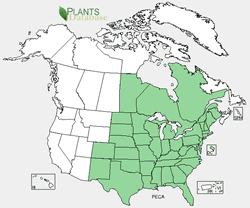Plant of the Week
 Pedicularis canadensis range map. USDA PLANTS Database.
Pedicularis canadensis range map. USDA PLANTS Database.
 Pedicularis canadensis. Photo by William Glass.
Pedicularis canadensis. Photo by William Glass.
 Pedicularis canadensis. Notice the difference in coloration of the two plants’ flowers on this and the image above; from bright yellow on all petals (above) to yellow with a rose-violet upper petal. Photo by Wayne Owen.
Pedicularis canadensis. Notice the difference in coloration of the two plants’ flowers on this and the image above; from bright yellow on all petals (above) to yellow with a rose-violet upper petal. Photo by Wayne Owen.
Wood Betony (Pedicularis canadensis L.)
By Eric Ulaszek, Horticulturist, Midewin National Tallgrass Prairie
Wood betony is a perennial forb that spreads from clumps by short rhizomes. Plants form a low but dense basal rosette. The leaves are sometimes semi-evergreen, often reddish in spring or in full-sun. The lanceolate to oblong leaves may grow to up to 20 cm, but are usually shorter. The leaf blades are pinnately dissected, usually into lobes, but small leaves are just coarsely toothed. Rosettes produce a leafy stem during early spring (late February to late May), with a terminal inflorescence. The inflorescence is a spike, usually solitary on the stem. Flowers progressively open from the bottom upwards. Wood betony may be in flower during March-April in the southern portions of its range and May-June in the northern portions. The flowers are usually yellow, but sometimes can be a reddish-purple or even bicolored (yellow and purple). Yellow, however, is the most frequent flower color. Bumblebees avidly visit the flowers, which are shaped so as to encourage pollinators with long tongues. After the flowering, the seeds develop in capsules. The capsules dehisce explosively, and all the seed is often dispersed within a few weeks after flowering ends, but empty seed heads may persist into mid-summer.
Wood betony is widespread in eastern North America, ranging from southern Canada (Quebec to Manitoba) south to northern Florida and west to eastern Texas. There are isolated populations further west, ranging from Colorado south to northern Mexico. Wood betony grows in dry woodlands, sandy oak savannas, upland prairies, and in rocky riparian woodlands. Sometimes wood betony will persist in the lawns of infrequently mowed pioneer cemeteries.
The alternative name “lousewort” refers to a erroneous belief that livestock grazing on pastures containing the plant would become infested with lice. Even the genus name “Pedicularis” is derived from the classical word Pediculus, meaning “a louse”. However, the European herders that named the plant were probably not aware that louseworts were, like lice, parasites! Technically, wood betony is a hemiparasite, a plant that is partially dependent upon other plants as a source of water and nutrients. Wood betony accomplishes this through haustoria, tissue connections that develop between the roots of the wood betony and its host plants. The precise identity of lousewort’s host plants remain uncertain, as might be expected from a wide-ranging species that occurs in diverse habitats. A number of plant species have been reported as hosts, including native trees (especially oaks) and native prairie grasses. Unlike plants that are completely parasitic, wood betony can uptake some water and minerals through its own roots. Wood betony also has green leaves containing chlorophyll, so the plants make their own carbohydrates through photosynthesis. In tallgrass prairies, the hemiparasitic wood betony may actually promote plant diversity; through parasitism, this species apparently hinders the growth of competitive tall grasses, allowing the shorter and less vigorous bunch grasses and forbs to dominate patches of prairie.

